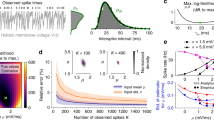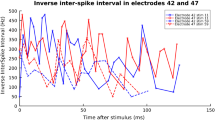Abstract
There is a potential for improved efficacy of neural stimulation if stimulation levels can be modified dynamically based on the responses of neural tissue in real time. A neural model is developed that describes the response of neurons to electrical stimulation and that is suitable for feedback control neuroprosthetic stimulation. Experimental data from NZ white rabbit retinae is used with a data-driven technique to model neural dynamics. The linear-nonlinear approach is adapted to incorporate spike history and to predict the neural response of ganglion cells to electrical stimulation. To validate the fitness of the model, the penalty term is calculated based on the time difference between each simulated spike and the closest spike in time in the experimentally recorded train. The proposed model is able to robustly predict experimentally observed spike trains.





















Similar content being viewed by others
References
Abbas, J.J., & Chizeck, H.J. (1991). Feedback control of coronal plane hip angle in paraplegic subjects using functional neuromuscular stimulation. IEEE Transactions Biomedical Engineering, 38, 687–698.
Dayan, P., & Abbott, L.F. (2001). Theoretical neuroscience: computational and mathematical modeling of neural systems: MIT press.
Chichilnisky, E.J. (2001). A simple white noise analysis of neuronal light responses. Network: Computation in Neural Systems, 12, 199–213.
Clark, G. (2003). Cochlear implants: fundamentals and applications: Springer.
Cooper, H.R., & Craddock, L.C. (Eds.) (2006). Cochlear implants: a practical guide: Wurr Publishers.
Fountas, K.N., Smith, J.R., Murro, A.M., Politsky, J., Park, Y.D., & Jenkins, P.D. (2005). Implantation of a closed-loop stimulation in the management of medically refractory focal epilepsy. Stereotact. Functional Neurosurgery, 83, 153–158.
Gerstner, W., & Kistler, W. M. (2002). Spiking neuron models: single neurons, populations, plasticity. Cambridge: Cambridge University Press.
Goodwin, G.C., Graebe, S.F., & Salgado, M.E. (2001). Control Systems Design: Prentice Hall International.
Gorzelic, P., Schiff, S.J., & Sinha, A. (2013). Model-based rational feedback controller design for closed-loop deep brain stimulation of Parkinson’s disease. Journal of Neural Engineering, 026016.
Jepson, L.H., Hottowy P., Matheson K., Gunning, D.E., Dabrowski, W., Litke, A.M., & Chichilnisky, E.J. (2014a). Spatially patterned electrical stimulation to enhance resolution of retinal prostheses. Journal of Neuroscience, 34(14), 4871–4881.
Jepson, L. H., Hottowy, P., Weiner, G. A., Dabrowski, W., Litke, A. M., & Chichilnisky, E. J. (2014b). High-fidelity reproduction of spatiotemporal visual signals for retinal prosthesis. Neuron, 83, 87–92.
Kalia, S.K., Sankar, T., & Lozano, A.M. (2013). Deep brain stimulation for Parkinson’s disease and other movement disorders. Current Opinion, 26(4), 374–380.
Keat, J., Reinagel, P., Reid, R.C., & Meister, M. (2001). Predicting every spike: a model for the responses of visual neurons. Neuron, 30, 803–817.
Koch, C., & Segev, I. (1998). Methods in neuronal modeling: from ions to networks. MIT press.
Lesica, N.A., Jin, J., Weng, C., Yeh, C.I., Butts, D.A., Stanley, G.B., & Alonso, J.M. (2007). Adaptation to stimulus contrast and correlations during natural visual stimulation. Neuron, 55, 479–491.
Mark, R.E., Jones, B.W., Watt, C.B., & Strettoi, E. (2003). Neural remodeling in retinal degeneration. Progress Retinal Eye Research, 22(5), 607–655.
McNeal, D.R. (1976). Analysis of a model for excitation of myelinated nerve. IEEE Transactions on Biomedical Engineering, 23(4), 329–337.
Muller, J., Bakkum, D. J., & Hierlemann, A. (2013). Sub-millisecond closed-loop feedback stimulation between arbitrary sets of individual neurons. Frontiers in Neural Circuits, 6(121), 1–11.
Nelson, T.S., Suhr, C.L., Freestone, D.R., Lai, A., Halliday, A.J., McLean, K.J., Burkitt, A.N., & Cook, M.J. (2011). Closed-loop seizure control with very high frequency electrical stimulation at seizure onset in the GEARS model of absence epilepsy. Journal of Neural Systems, 21(2), 163–173.
Nirenberg, S., Bornash, I., Pillow, J.W., & Victor J.D. (2010). Heterogeneous response dynamics in retinal ganglion cells: the interplay of predictive coding and adaptation. Journal of Neurophysiology, 103, 3184–3194.
Tukhlina, N., & Rosenblum, M. (2008). Feedback suppression of neural synchrony in two interacting pPopulations by vanishing stimulation. Journal of Biological Physics, 34, 301– 314.
Parker, J., Karantonis, D., Single, P., & Obradovic, M. (2012). Compound action potentials recorded in the human spinal cord during neurostimulation for pain relief. Pain, 153(3), 593– 601.
Pillow, J.W., Paninski, L., Uzzell, V.J., Simoncelli, E.P., & Chichilnisky, E.J. (2005). Prediction and decoding of retinal ganglion cell responses with probabilistic spiking model. Journal of Neuroscience, 25(47), 11003–11013.
Pulver, S.R., & Griffith, L.C. (2010). Spike integration and cellular memory in a rhythmic network from Na/K pump current dynamics. Nature Neuroscience, 13, 53–59.
Rattay, F. (1999). The basic mechanism for the electrical stimulation of the nervous system. Neuroscience, 89 (2), 335–346.
Rose, T., Gras, H., & Horner, M. (2007). Activity-dependent suppression of spontaneous spike generation in the Retzius neurons of the leech Hirudo medicinalis L. Invertebrate Neuroscience, 6(4), 169–176.
Rosin, B., Slovik, M., Mitelman, R., Rivlin-Etzion, M., Haber, S.N., Israel, Z., Vaadia, E., & Bergman H. (2011). Closed-loop deep brain stimulation is superior in ameliorating Parkinsonism. Neuron, 72(2), 370–384.
Schiff, S.J. (2009). Kalman meets neuron: the emerging intersection of control theory with neuroscience. Proceedings of the IEEE EMBS conference, 1–4.
Sun, J.J., Kilb, W., & Luhmann, H.J. (2010). Self-organization of repetitive spike patterns in developing neuronal networks in vitro. European Journal of Neuroscience, 1–11.
Stingl, et al (2013). Artificial vision with wirelessly powered subretinal electronic implant alpha-IMS. Proceedings of the Royal Society: Biological Sciences, 280(1757), 20130077.
van Hateren, J.N., Ruttiger, L., Sun, H., & Lee, B.B. (2002). Processing of natural temporal stimuli by macaque retinal ganglion cells. Journal of Neuroscience, 22(22), 9945–9960.
Victor, J.D., & Purpura, K.P. (1997). Metric-space analysis of spike trains: theory, algorithms and application. Network: Computation in Neural Systems, 8, 127–164.
Vetter, A.H., Masani, K., Nakazawa, K., & Popovic, M.R. (2010). Neural-mechanical feedback control scheme generates physiological ankle torque fluctuation during quiet stance IEEE. Transactions on Neural Systems Rehabililation Engineering, 18(1), 86–95.
Wallach, A., Eytan, D., Gal, A., Zrenner, C., & Marom, S. (2011). Neuronal response clamp. Frontiers in Neuroengineering, 4, 1–10.
Zimmermann, J. B., & Jackson, A. (2014). Closed-loop control of spinal cord stimulation to restore hand function after paralysis. Frontiers in Neuroscience, 10, 3389.
Acknowledgments
This research was supported by the Australian Research Council (DE120102210). The Bionic Ear Institute acknowledges the support it receives from the Victorian Government through its Operational Infrastructure Support Program. This research was supported by the Australian Research Council through its Special Research Initiative in Bionic Vision Science and Technology grant to Bionic Vision Australia. NICTA is funded by the Australian Government as represented by the Department of Broadband, Communications and the Digital Economy and the Australian Research Council through the ICT Centre of Excellence program.
Conflict of interests
The authors declare that they have no conflict of interest
Author information
Authors and Affiliations
Corresponding author
Additional information
Action Editor: Tim Gollisch
Rights and permissions
About this article
Cite this article
Kameneva, T., Abramian, M., Zarelli, D. et al. Spike history neural response model. J Comput Neurosci 38, 463–481 (2015). https://doi.org/10.1007/s10827-015-0549-5
Received:
Revised:
Accepted:
Published:
Issue Date:
DOI: https://doi.org/10.1007/s10827-015-0549-5




